Nutrition advice is everywhere on social media, in magazines, from friends but it can be tough to know what’s actually useful. That’s where a solid book comes in. The best nutrition books don’t just hand you a diet plan, they explain how food works, clear up common myths, and help you make better choices without the confusion. Whether you want to improve your health, rethink your meals, or just understand what you’re eating, this list is a good place to start.
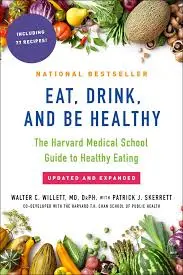
1. Eat, Drink, and Be Healthy: The Harvard Medical School Guide to Eating
Written by Walter Willett, MD, DrPH, Eat, Drink, and Be Healthy is a nutrition book that compiles dietary guidance based on population-level studies and long-term health research. The book presents dietary guidance based on research, occasionally diverging from older U.S. government guidelines while building on evidence from population studies. It avoids fixed meal plans and instead describes broader suggestions such as increasing intake of plant-based foods and reducing reliance on red meats, saturated fats, and highly refined carbohydrates.
The content is shaped by epidemiological data, which the author uses to support associations between dietary habits and common health outcomes. Several claims are accompanied by citations and scientific context, though not all points are uniformly supported by clinical trials. The book includes a section on multivitamin use, referencing a broad range of studies, including meta-analyses, while noting areas where research findings are mixed or inconclusive.
Key Highlights:
- Based on findings from observational nutrition studies
- Discusses associations between certain food groups and health outcomes
- Describes common dietary patterns without prescribing rigid plans
- Contains references and source citations for most claims
Who it’s best for:
- Readers interested in nutrition guidance drawn from large-scale research
- Individuals looking for food-related reading with cited sources
- Those exploring non-restrictive approaches to diet
- People seeking an overview of food intake patterns and their potential effects
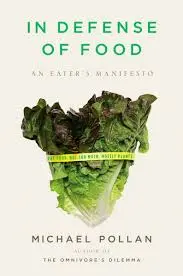
2. In Defense of Food
In Defense of Food: An Eater’s Manifesto by Michael Pollan explores how food consumption has changed in recent decades, particularly in the context of the Western diet. The book discusses the shift from traditional eating habits toward processed food products and the growing influence of nutrition science in shaping public understanding of food. It critiques the concept of “nutritionism,” which focuses on isolated nutrients instead of whole foods or broader dietary patterns.
Pollan’s writing presents a perspective that questions how food production, marketing, and scientific discourse have contributed to confusion about what constitutes healthy eating. The book centers on the idea that modern dietary trends have altered not just what people eat, but also how and where they eat. Framed more as an exploration than a prescription, it raises questions about the food system, eating environments, and the role of industrial processing in everyday meals.
Key Highlights:
- Discusses changes in food culture and eating behaviors
- Critiques the rise of nutrient-based dietary advice
- Highlights the influence of food industry practices
- Reflects on how eating contexts have shifted over time
- Emphasizes traditional food recognition and preparation
Who it’s best for:
- Readers interested in the social and cultural aspects of eating
- Individuals examining the impact of food processing and labeling
- Those exploring the history of dietary advice
- People looking for a reflective approach to food and consumption
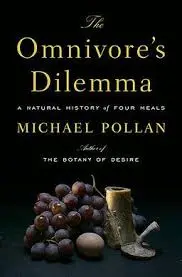
3. The Omnivore’s Dilemma
The Omnivore’s Dilemma: A Natural History of Four Meals by Michael Pollan examines the sources of food in the United States by tracing the components of four meals through different food systems: industrial, organic, local, and foraged. The book documents the production processes behind each type of meal and explores how food moves from its origin to the dinner plate. It focuses on the systems that support food availability and how these systems function on both large and small scales.
The narrative combines reporting, research, and personal observation to present a detailed account of contemporary food supply chains. Topics include agricultural practices, processing methods, distribution networks, and eating habits. The book discusses how human food choices relate to broader systems, including land use, supply logistics, and consumption patterns, without offering specific prescriptions or conclusions.
Key Highlights:
- Examines four food production models: industrial, organic, alternative, and foraged
- Describes how food is sourced, processed, and consumed
- Focuses on production systems rather than dietary advice
- Includes observational reporting from farms, fields, and supply chains
- Explores connections between food habits and broader systems
Who it’s best for:
- Readers interested in understanding food supply structures
- Individuals exploring the role of agriculture and industry in modern eating
- Those examining the relationships between consumption and environment
- People looking for descriptive accounts of how food reaches consumers
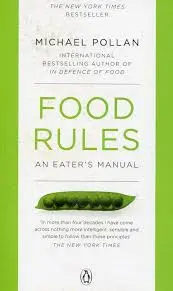
4. Food Rules
Food Rules: An Eater’s Manual by Michael Pollan offers a condensed set of principles about eating, presented as short, easily digestible statements. The book aims to simplify decisions around food by providing brief rules each one given its own page with minimal elaboration. These guidelines are influenced by various cultural traditions and shared ideas about food that have persisted over time.
The content avoids detailed scientific explanations or deep analysis, focusing instead on accessible and general observations about eating behaviors. The format is structured to be quick to read and easy to reference, addressing common questions about how to navigate food choices in everyday settings such as grocery stores or dining situations.
Key Highlights:
- Presented as a list of short, individual rules about food
- Draws from a range of cultural perspectives on eating
- Avoids technical nutrition language or extensive analysis
- Organized for quick reading and reference
- Emphasizes general patterns of eating rather than specific diets
Who it’s best for:
- Individuals seeking a simplified guide to food decisions
- Readers interested in cultural food habits
- People looking for a non-technical, quick-reference approach
- Those navigating everyday food choices without in-depth study
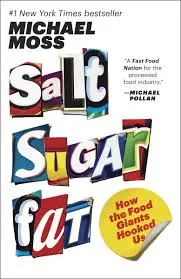
5. Salt Sugar Fat: How the Food Giants Hooked Us
Salt Sugar Fat: How the Food Giants Hooked Us by Michael Moss explores how processed food manufacturers have developed products built around the concentrated use of salt, sugar, and fat. The book draws on internal industry materials, interviews, and technical accounts to outline how these ingredients are used not only for preservation and flavor but also to influence consumer preferences and eating behavior on a large scale.
The content focuses on corporate practices related to product formulation and advertising. It covers how food companies apply research to refine taste, texture, and mouthfeel, as well as how marketing efforts have been structured to align with consumer habits and regulatory limitations. Specific case studies involve well-known companies and brands, emphasizing recurring strategies used across the processed food sector.
Key Highlights:
- Examines the use of salt, sugar, and fat in large-scale food production
- Describes how sensory factors like sweetness and texture are engineered
- Explores internal industry communications and product development approaches
- Discusses marketing and branding practices related to processed food
- Based on reporting from company archives, interviews, and research
Who it’s best for:
- Readers interested in the inner workings of the food manufacturing industry
- Individuals examining how ingredient choices affect product design
- Those looking into the history of processed food marketing
- People studying the intersection of food science and consumer behavior
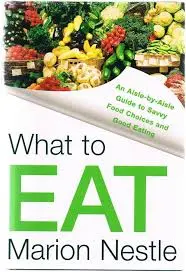
6. What to Eat
What to Eat by Marion Nestle presents an organized overview of the modern U.S. supermarket, using its layout to frame discussions on various food categories such as produce, dairy, meats, seafood, and packaged goods. The book outlines the labeling practices, marketing strategies, and regulatory structures that shape how foods are presented to consumers. Rather than prescribing a specific diet, it focuses on explaining how food systems function and how information about nutrition is often framed.
The book includes commentary on federal food policy, product labeling standards, and the influence of corporate interests in food marketing. Nestle examines how terms like “natural” or “organic” are used on packaging, as well as how lobbying and subsidies may shape the types of products that are widely available. Emphasis is placed on the variety of factors that can affect purchasing decisions, from shelf placement to advertising claims, without offering clear-cut conclusions about what individuals should or should not eat.
Key Highlights:
- Structured around typical supermarket sections
- Explores how marketing and policy affect food presentation
- Discusses government roles in regulating food safety and labeling
- Covers a broad range of food products and related health claims
- Examines the relationship between product availability and consumer decision-making
Who it’s best for:
- Readers seeking to understand the structure of food retail environments
- Individuals examining how regulatory frameworks shape food choices
- People looking into the role of marketing in consumer nutrition perceptions
- Those interested in the connections between food policy and public health
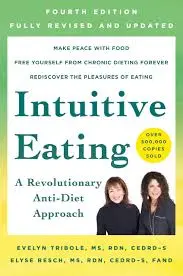
7. Intuitive Eating, 4th Edition
Intuitive Eating by Evelyn Tribole and Elyse Resch outlines a framework intended to shift the way people relate to food and body image. First introduced in the 1990s, this approach moves away from traditional dieting methods and emphasizes internal cues such as hunger, satisfaction, and emotional wellbeing. The fourth edition includes updates that reflect recent conversations around weight stigma, diet culture, and mental health.
The book presents ten principles designed to help individuals reconnect with their natural eating instincts while examining the psychological and social pressures that can shape food choices. The authors also address topics related to eating disorders, body respect, and the broader cultural narratives around body image. The structure encourages a flexible, individualized path rather than rigid guidelines or prescribed outcomes.
Key Highlights:
- Introduces ten core principles of intuitive eating
- Discusses the psychological impact of chronic dieting
- Includes tools for responding to hunger, fullness, and satisfaction
- Explores the concept of body respect and emotional eating
- Updated with guidance on weight stigma and social influences
Who it’s best for:
- Individuals seeking alternatives to restrictive dieting
- Readers exploring relationships between food, emotion, and self-image
- Those recovering from disordered eating patterns
- People interested in frameworks that prioritize internal cues over external rules
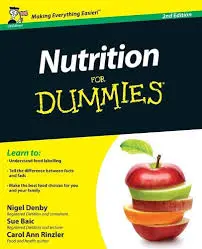
8. Nutrition For Dummies
Nutrition For Dummies by Carol Ann Rinzler provides a general overview of human nutrition, written in an accessible, instructional format. The book explains core concepts such as macronutrients, micronutrients, food labels, and meal planning, and includes updated dietary recommendations based on government guidelines. It aims to serve as a foundational reference for individuals looking to understand how nutrition works and how to apply that knowledge in everyday life.
This edition includes revisions aligned with current U.S. Dietary Guidelines and Recommended Daily Allowances. It also addresses practical aspects of nutrition, such as preparing meals at home, evaluating supplement claims, and interpreting ingredient lists on packaged foods. The tone is instructional rather than prescriptive, with an emphasis on clarifying terms and debunking common food myths. It is formatted to allow readers to browse topics individually or follow along sequentially.
Key Highlights:
- Covers fundamental nutrition topics (fats, carbs, protein, vitamins, minerals)
- Includes updated dietary recommendations and label-reading tips
- Offers guidance for home cooking, eating out, and supplement use
- Designed in an educational format with chapter-based breakdowns
- Emphasizes practical application of nutrition knowledge
Who it’s best for:
- Readers seeking a broad introduction to nutrition concepts
- Individuals looking to understand food labeling and dietary guidelines
- Those interested in nutrition without following a specific diet plan
- Anyone revisiting or updating their understanding of basic health science
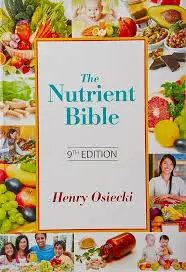
9. Nutrient Bible
The Nutrient Bible by Henry Osiecki is a reference book that compiles information on a wide range of nutritional compounds, including vitamins, minerals, amino acids, enzymes, and other micronutrients. The book outlines the structural characteristics, dietary sources, and metabolic roles of each nutrient, along with data related to recommended intake levels and deficiency indicators. It also presents material on interactions between nutrients and pharmaceutical compounds.
The 9th edition includes updated entries and additional chapters covering flavonoids and polyphenols. Tables and diagrams are included to illustrate nutrient pathways and compound structures. A portion of the book is dedicated to listing nutrient associations with various health conditions, presented in a catalog-style format for quick reference.
Key Highlights:
- Includes over 150-200 entries on individual nutrients and compounds.
- Presents information on nutrient intake ranges and deficiency symptoms
- Contains sections on drug-nutrient interactions and metabolic roles
- Offers structured diagrams and tables for reference
- Covers compounds such as flavonoids and polyphenols
Who it’s best for:
- Nutrition and health science students
- Readers researching nutrient function and biochemistry
- Those seeking a reference on nutrient classification and interactions
- Individuals looking to cross-reference nutrients with specific physiological roles
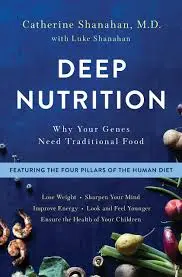
10. Deep Nutrition: Why Your Genes Need Traditional Food
Deep Nutrition by Catherine Shanahan, M.D. investigates how traditional food practices may influence genetic expression and long-term health. The book reviews eating patterns from various global diets such as those from the Mediterranean and Okinawan regions known for their association with longevity and generational well-being.
The content is structured around four nutritional pillars: fresh foods, fermented and sprouted items, meat prepared on the bone, and organ meats. The book also incorporates references to biochemistry and epigenetics to explore the possible link between food and biological development.
Key Highlights:
- Focuses on four traditional food principles: fresh, fermented/sprouted, bone-cooked meat, and organ meats
- Reviews dietary patterns from cultures known for long lifespans
- Discusses connections between diet and gene expression
- Uses examples from nutrition science and cellular biology
Who it’s best for:
- Readers interested in cross-cultural nutrition research
- Those exploring the role of diet in long-term biological development
- People looking for historical context on food and health
- Individuals researching how dietary practices might influence generational health patterns
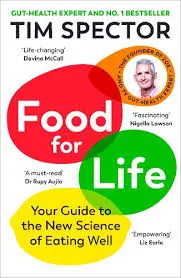
11. Food for Life: The New Science of Eating Well
Food for Life by Tim Spector explores the evolving science behind nutrition and the broader role of food in human health, the environment, and society. The book compiles over a decade of research and presents an overview of various topics including food’s impact on gut microbes, mental health, immunity, and sustainability.
Rather than focusing on traditional calorie counts or isolated nutrients, Spector examines food in a more holistic context. The book also addresses broader issues such as food labeling practices, the influence of ultra-processed foods, and how dietary habits intersect with environmental concerns. It aims to present nutrition as an interconnected system, drawing attention to both scientific findings and public misconceptions.
Key Highlights:
- Covers the relationship between food and gut microbiota
- Discusses food’s impact on mental health and immunity
- Looks at sustainability and environmental effects of dietary choices
- Includes sections on food labeling, allergies, and food fraud
- Challenges conventional views of calorie-based dieting
Who it’s best for:
- Readers interested in the broader science behind nutrition
- Those looking to understand how food affects different body systems
- People exploring the environmental and ethical aspects of eating
- Individuals curious about how dietary science is evolving beyond traditional guidelines

12. Ultra-Processed People: The Science Behind the Food We Eat
Ultra-Processed People by Chris van Tulleken explores the development and effects of ultra-processed foods (UPFs) within modern food systems. The book looks at how industrial food production methods have changed what people eat, focusing on the rise of highly modified products made from ingredients not typically used in home kitchens. It examines how these products are created, marketed, and consumed across societies.
Van Tulleken approaches the topic through personal experience and investigation, including adopting a UPF-heavy diet and analyzing existing scientific research. The book addresses the connections between UPFs and public health, discusses corporate influence over food policy and advertising, and questions how much control individuals truly have over what they eat within the current food environment.
Key Highlights:
- Describes what qualifies as ultra-processed food and how it differs from minimally processed items
- Examines links between UPFs and patterns in health and weight
- Considers how food processing intersects with economics and regulation
- Includes commentary on branding, labeling, and food industry practices
- Touches on the potential environmental costs of large-scale food production
Who it’s best for:
- Readers interested in the science and politics of modern nutrition
- Individuals exploring the impact of diet on long-term health
- Those seeking context around food labeling and processing
- Anyone analyzing food culture through a structural or policy lens
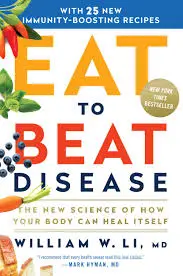
13. Eat to Beat Disease
Eat to Beat Disease by William W. Li, MD, presents information on how certain foods may interact with biological systems involved in maintaining health. The book focuses on five of the body’s internal defense mechanisms: angiogenesis, regeneration, the microbiome, DNA protection, and immunity and discusses how components found in food may influence these systems. The content is structured around current research findings and examples from nutritional science.
Discusses a wide range of foods, including examples like jasmine tea, plums, cinnamon, sourdough bread, black beans, olive oil, and specialty items like certain mushrooms. It describes how these items are linked to various biological pathways, offering examples of how they could be included in daily meals. Rather than emphasizing dietary restriction, the book outlines a framework for using food as a potential part of long-term health strategies.
Key Highlights:
- Focus on five biological systems: angiogenesis, regeneration, microbiome, DNA protection, immunity
- Discusses a wide range of foods and their roles in research-based health models
- Includes common food items such as San Marzano tomatoes, Pacific oysters, Jarlsberg cheese, and red wine
- Emphasis on incorporating specific foods rather than eliminating categories
Who it’s best for:
- Readers interested in the scientific relationship between food and health systems
- Those looking to expand their understanding of food beyond basic nutrition facts
- Individuals curious about how common foods are studied in health-related contexts
- People seeking a structured overview of food’s role in biological functions without prescriptive diet plans
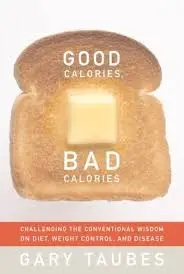
14. Good Calories, Bad Calories: Challenging the Conventional Wisdom on Diet, Weight Control, and Disease
Good Calories, Bad Calories by Gary Taubes examines the scientific and historical foundations of modern dietary guidelines. The book explores how prevailing views about fat, carbohydrates, and calorie consumption have shaped public health advice over the past several decades. Taubes presents an analysis of medical studies, policy decisions, and nutrition science debates to question the assumption that all calories have the same effect on the body.
Instead of providing a diet plan, the book focuses on how certain types of calories particularly those from refined carbohydrates and sugars may influence fat storage, insulin levels, and disease outcomes. It also looks into how scientific research has been interpreted or misinterpreted in shaping dietary recommendations.
Key Highlights:
- Investigates the historical development of dietary guidelines
- Analyzes the role of carbohydrates and insulin in fat storage
- Discusses the impact of refined sugars and processed foods on health
- Explores how scientific research and health policy intersect
Who it’s best for:
- Readers interested in the history of nutrition science
- Individuals looking to understand critiques of mainstream dietary advice
- Those researching the links between diet, metabolism, and chronic illness
- People seeking a detailed, evidence-based discussion on food and health policy
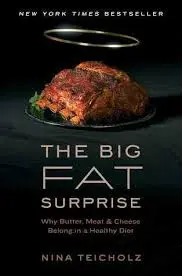
15. The Big Fat Surprise: Why Butter, Meat and Cheese Belong in a Healthy Diet
The Big Fat Surprise by Nina Teicholz investigates how dietary guidelines regarding fat, particularly saturated fat have developed over time and questions the scientific basis behind decades of low-fat dietary advice. The book presents findings from a multi-year journalistic investigation into the origins and impact of mainstream nutrition recommendations.
Drawing on historical research, government policy analysis, and recent scientific studies, the book explores how dietary fat became widely viewed as harmful, and how this view has shaped public health messaging, food industry practices, and consumer behavior. Teicholz also looks at how more recent evidence challenges earlier assumptions, particularly regarding the health implications of saturated fats and animal-based foods.
Key Highlights:
- Traces the origins of low-fat dietary advice
- Examines how institutional decisions shaped nutritional science
- Reviews research that questions the risks associated with saturated fat
- Analyzes the role of bias and consensus in shaping dietary guidelines
Who it’s best for:
- Readers interested in the history and politics of nutrition science
- Individuals exploring alternative perspectives on dietary fat
- Researchers or students studying public health policy
- Anyone seeking a critical review of long-standing dietary recommendations

16. Fiber Fueled: The Plant-Based Gut Health Program
Fiber Fueled by Will Bulsiewicz, MD, focuses on the relationship between dietary fiber and gut health. Drawing from microbiome research, the book outlines a dietary approach based on plant diversity, emphasizing fiber-rich foods such as fruits, vegetables, legumes, and whole grains. It explores how these foods interact with the digestive system and affect various functions related to health and metabolism.
The book contrasts its approach with low-carbohydrate and elimination diets, raising concerns about the long-term effects of reduced fiber intake. Includes a 4-week meal plan and over 70–80 plant-based recipes. The content is framed around the author’s clinical background and research in gastroenterology, with added attention to common topics like food sensitivities and microbiome balance.
Key Highlights:
- Discusses how fiber affects the microbiome and digestion
- Explores short-chain fatty acids and their role in gut health
- Covers food sensitivities and ways to gradually diversify the diet
- Includes a 4-week meal plan and over 70–80 plant-based recipes
- Addresses common gastrointestinal concerns and misconceptions
Who it’s best for:
- Individuals interested in gut health and digestion
- Readers looking for plant-based diet frameworks
- Those navigating dietary transitions or food sensitivities
- Anyone curious about the connection between fiber and overall wellness
Conclusion
When it comes to nutrition, there’s no one-size-fits-all answer but the books on this list offer a wide range of perspectives to help you figure out what works best for you. Some dive deep into gut health, others unpack the science behind fats, carbs, or ultra-processed foods, and a few challenge popular diet trends altogether. Whether you’re looking to better understand your body, make more informed food choices, or just curious about what the latest research is saying, these books are a solid starting point.
At the end of the day, nutrition is personal. The best book for you is the one that fits your goals, your values, and your lifestyle. Take what makes sense, question what doesn’t, and keep learning because how we eat really does shape how we feel, think, and live.

Leave a Reply